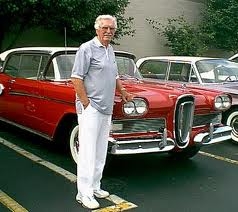
I remember my father, who had a 45+ year career in industrial/commercial sales and marketing, having an interesting artifact hanging on the wall of his office: a hubcap from a 1958 Ford Edsel sedan.
It was an interesting prop because it represents one of the biggest marketing flops in American automotive history … and underscores what can happen when product development efforts ignore what market research is telling them.
Recently, Roy Brown, Jr., one of the key players in the Edsel fiasco, passed away at the age of 96. As the lead designer on the product, Mr. Brown bore the brunt of blame for the “glorious failure” that was the Edsel.
Of course, that rap isn’t entirely fair; introducing a new motor car is a team effort that involves a host of people. And in the case of the Edsel, the design of the vehicle was only one of several key failures.
Consider just how many ways the Edsel ran afoul of good product development practices:
- The car was developed based on out-of-date consumer research. The late 1950s was the beginning of changing consumer tastes in car designs: moving away from exuberant fins and outlandish colors and towards a more refined style. By the time the Edsel became available at dealerships, consumer tastes had shifted and the country was in a recession.
- The design of the car was controversial. Its most memorable design feature was its “horse collar” grille, unfortunately referred to by some as a toilet seat. It was different from any other car on the market — but the notoriety wasn’t positive. Some wags joked that the car’s front resemble “an Oldsmobile sucking a lemon,” while others were even less charitable, noting that the grille design was suggestive of a giant vulva.
- Despite undertaking a highly publicized naming effort for the vehicle that ultimately reached more than 6,000 possibilities being considered, Ford rejected all of these suggestions and chose to name the car after the lone son of company’s founder. The “Edsel” – a clunker of a car name if ever there was one – did nothing to endear the buying public to the brand, seeming more like corporate nepotism taken to the extreme.
Ford predicted great things for the Edsel. The company launched a glitzy ad campaign for the automobile in 1957, touting it as a revolutionary “car of the future” and projecting first-year unit sales of more than 200,000 vehicles.
Instead, when it debuted in Ford showrooms in 1958 carrying a list price between $2,300 and $3,800, consumers were distinctly underwhelmed.
But even with disastrous first-year sales, Ford limped along with the Edsel until finally killing the brand in 1960. In all, only ~100,000 Edsels had been sold over three model years.
The total cost of the Edsel boondoggle to Ford was ~$350 million, which translates into nearly $2.8 billion in today’s dollars.
Roy Brown was the man held most responsible for the failure of the Edsel. But ever the optimist, the designer didn’t let this become the end of his career. In fact, Brown bounced back to work on successful new introductions such as the Ford Falcon and Mercury Comet. These turned out to be everything the Edsel wasn’t.
Mr. Brown didn’t disown his star-crossed child, either. In fact, he drove his own Edsel car (a stunning fire-engine red model) nearly to the end of his life — no doubt happy to know that in later years, mint-condition and restored Edsel cars were selling for upwards of $100,000 apiece. And there are highly active Edsel car clubs with members located throughout the United States and Canada.
So, maybe it’s not such a bad legacy in the end.
